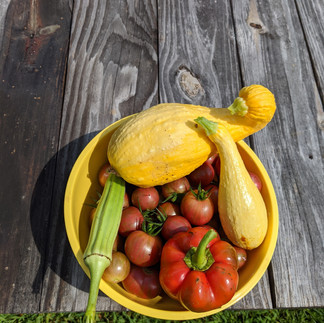Summer Harvesting 101
- thepatiofarmer
- Jul 12, 2023
- 2 min read
Here are just a few things to keep top of mind as you're harvesting summer veg -- from how to know when they're ready to post-harvest storage.
Basil: You can trim entire stalks or leaves as needed from these plants. Start from the bottom and the exterior of the plant when harvesting. Once harvested, store leaves / stems on the counter and keep excess moisture off the leaves. This will lead to browning!
Cucumbers: The size of the fruit depends on the variety so be sure to look up the ideal harvest size for the variety you're growing. Cucumbers should gently release from the vine when tugged. The more effort you have to go to to pull the plant from the vine, the less likely it is to be ready to come off the vine!
Eggplant: Similar guidance goes here as for peppers, particularly around the fragility of the plants and being careful when harvesting. Eggplant and peppers are some of the most disease and pest resistant plants we can grow in the summer, meaning lots of happy harvests ahead!
Green Beans: Harvest your green beans before the pods are so mature you can see clear definition around the beans from the outside of the pod. The more developed the bean is inside, the more fibrous the pods. The younger the fruit the sweeter the taste!
Peppers: All peppers will be green first, then turn color. Fully mature fruit will have more developed sugars with their full color. Be very cautious when harvesting peppers. The fruit are heavy but the stems of the plant are fragile. Harvest or pruning shears can be super helpful here! Summer Squash: Like cucumbers, the size of harvestable squash depends on the variety being grown. Remind yourself of the size and shape you're looking for if you don't remember the specifics for what you're growing. When you harvest, gently twist or cut the fruit from stalk. Wipe clean and store in the fridge until you're ready to enjoy!
Tomatoes: You can harvest these summer fruits as soon as they start to "blush" or turn color. This is especially advisable if your plants are susceptible to bugs, birds, squirrels, deer, etc. as they ripen and sugars develop. You can also leave these on the vine until they have fully turned color, if your space is less precariously situated. After you harvest tomatoes, set them on the counter on their "shoulders" v. their "butts" to prevent post-harvest bruising. Now, go fill up them harvest baskets, friends!
















Comments